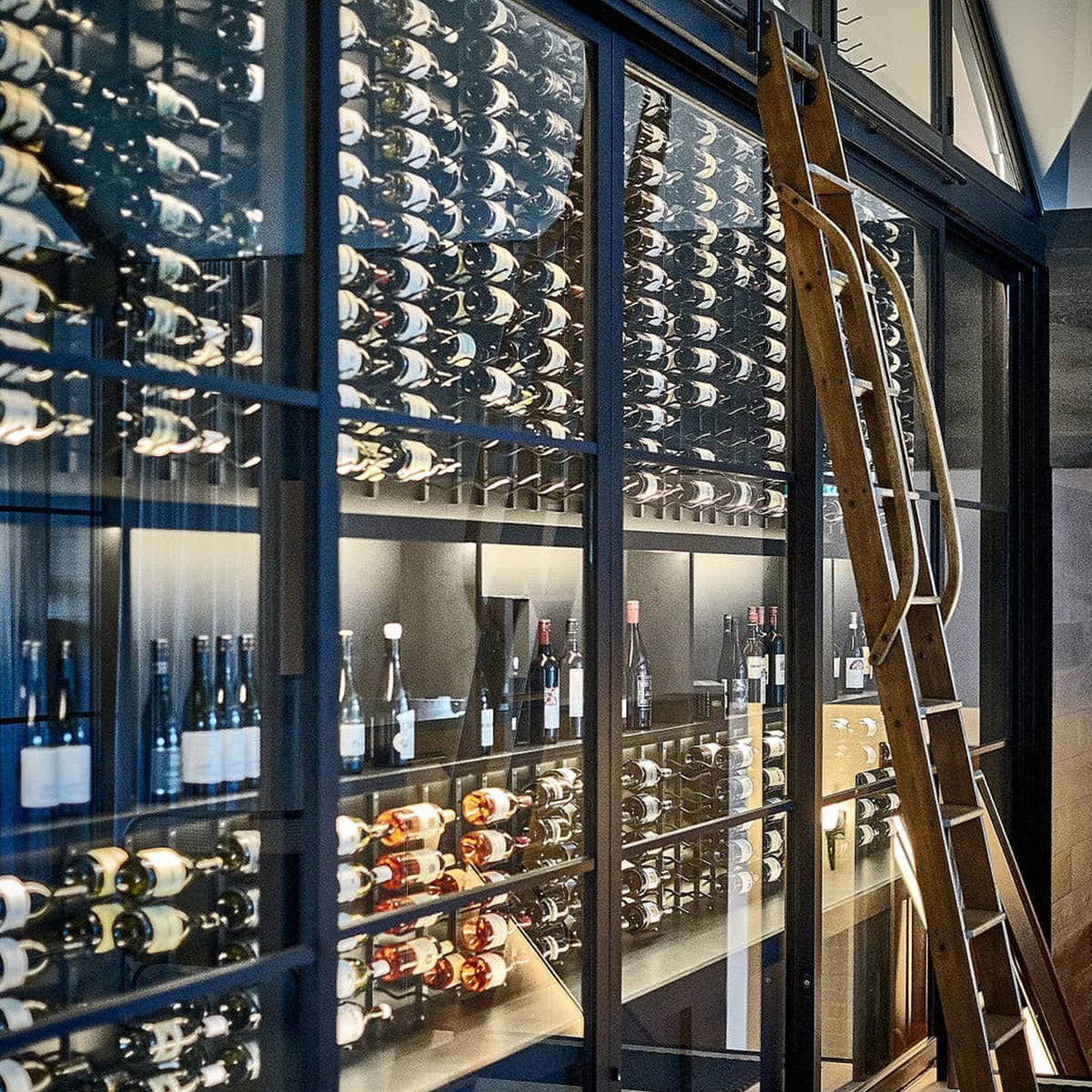Did your wine rack collapse, taking three of your prized bottles from your wine collection? The truth is, the type of racking material you use—wood, metal, acrylic, or cable systems—matters more than the price tag.
Based on our insights from Wine Cellar HQ, where we specialize in wine storage solutions, our guide reveals which materials protect your investment and beautifully store your collection, whether for a few bottles or a full cellar.
Table of Contents
1. Wood Wine Racks

VIEW PRODUCT
Wood is the most traditional and popular material for wine racks, with redwood, mahogany, and oak being the most recommended types due to their durability, stability, and lack of odor.
Why choose wooden wine racks?
-
Naturally insulates, helping keep wine cool and the cork moist
-
Offers timeless aesthetics in stained or unfinished styles
-
Easy to customize and expand based on your wine collection size
-
Stained works well in both traditional and contemporary wine storage designs
Popular wood types for wine racks:
-
Redwood: Known for moisture resistance and durability. Closest in properties to classic mahogany.
-
Mahogany: Rich in appearance and highly resilient. A top choice for serious collectors and wooden wine racks customers. It resists decay, maintains humidity, and is tougher than pine.
-
Oak: A strong, dense hardwood that offers excellent structural support.
-
Pine: Budget-friendly, lightweight, and resists warping. Great for DIYers storing a few wine bottles.
While pine can be used for wooden wine racks, it is less ideal for long-term wine storage.
Cedar is a popular choice for wine racks due to its natural beauty and aroma; however, it should be used with caution, as its scent can potentially penetrate the wine through the cork, potentially altering its flavor profile.
Vinostor Traditional 340 Bottle Wine Display with Table Top
-
Customizable
-
Premium wood and workmanship
-
Suits any budget
2. Metal Wine Racks

VIEW PRODUCT
Metal wine racks offer a polished look and are highly adaptable to both small and large areas. They're ideal for both wall-mounted and freestanding designs at home or businesses.
Stainless steel is an excellent choice for its durability, corrosion resistance, and modern aesthetic.
Benefits of metal wine racks:
-
Stainless steel and aluminum won’t warp
-
Ideal for tabletop or countertop wine racks, cabinets, or wall-mounted applications
-
Easy to clean
-
Great for minimalist and industrial-style interiors
-
Stackable options for when you want to expand your wine collection
Aluminum is a versatile choice for a shelf display, offering a lightweight and attractive option.
While it may require a bit more maintenance, its visual appeal and functionality make it a solid contender for display needs.
Urban Ironcraft Countertop Wine Racks
-
Made in the US
-
Hardwearing
-
Space-saving
3. Acrylic Wine Racks
VIEW PRODUCT
Acrylic racks are perfect solutions if you want your wine shelf and bottles to take center stage.
The transparent display of these wine racks showcases your wine selection labels, adding a taste of elegance to your wall and living space.
Why choose acrylic wine racks?
-
Lightweight and easy to move
-
Creates a high-end style with clear visibility
-
Best for customers with a few bottles, not ideal for large bottles or heavy collections
Keep in mind that acrylic can scratch easily. Use it for quality wall showpieces, but better maintenance is required for long-term storage.
Fusion Wine Wall (Cork Forward) - White Acrylic (4 Foot)
-
Maximum storage capacity
-
Cork out fashion
-
Option for LED
4. Floating Cable Wine Racks
VIEW PRODUCT
Floating cable systems utilize high-quality, tensioned steel cables to suspend wine bottles mid-air, creating a dramatic visual impact for your wall. Floating cable racks appeal to customers who want to make a showpiece wine wall without sacrificing practicality. They are compatible with various design styles and can serve both residential and commercial wine storage needs.
Ideal for:
-
Small rooms where the floor dimensions are limited
-
Modern wine bars or glass-enclosed displays
-
Highlighting bottle labels for better access
-
Adjustable for various bottle dimensions
Simple installation that requires minimal tools. Easy to clean and can be easily matched to your wall aesthetics.
Blue Grouse 12 Bottle Float Cable Wine Racking Display Kit
How to Choose the Best Wine Rack for Home
The best material depends on your storage goals, design preferences, and how you plan to use the rack.
Ask yourself:
-
Do I need something decorative or purely functional?
-
How many bottles will I store? Just a few, or am I expanding to an extensive collection?
-
Will it go on the kitchen countertop, in a wine cellar, or a business place? Decide before investing.
-
Do I want to prioritize sustainability, durability, or aesthetics in my wine storage?
Quick Comparisons
| Material | Best For | Notable Traits |
|---|---|---|
| Wood | Traditional homes, long-term cellars | Durable, insulating, aesthetic |
| Metal | Modern homes, compact nooks | Sleek, space-saving, sturdy |
| Acrylic | Visual displays, small collections | Lightweight, elegant, low capacity |
| Cable | Artistic layouts, small areas | Floating illusion, label visibility |
Key Takeaway
You now understand the trade-offs between the traditional appeal of wooden wine racks, the industrial strength of metal, the contemporary aesthetics of acrylic, and the adaptability of cable systems.
This knowledge helps you choose which option suits your wine collection, as it deserves more than a flimsy rack.
Select materials that age as gracefully as your wine, and seek sophisticated solutions for every space, budget, and collection size. Let us know which material won your heart in the comments below.
What's your next wine storage project? Drop us a line. We love helping fellow wine lovers build cellars they're proud to show off. FREE design consultation from our wine cellar experts.
FAQs: Wine Storage
What are wine racks made of?
Common materials include wood (such as mahogany and redwood), metal (stainless steel and aluminum), acrylic, and steel cables.
What are wine crates made of?
Typically, wood, such as oak, plywood, or cedar, is used for bulk storage or decoration.
Can drywall hold a wine rack?
Yes, if mounted on studs or with strong anchors, especially for wall-mounted metal or small wine racks. Alternative: Use floor-to-ceiling wine racks.
How to make a wine cubby?
DIY wine cubby designs often use MDF, pine, or plywood, and the size depends on the dimensions of the area. Check out this YouTube guide from Black Hills Wood Working for a beginner-friendly tutorial.
What makes a good wine rack?
Stability, air circulation, proper bottle angle, and component durability are all key factors for customers.
Does a wine cellar need a humidifier?
If your area has low humidity, yes, a humidifier helps keep your wine safe from temperature fluctuations. If you're dealing with the opposite issue, learn about some ways to lower the humidity in your wine cellar.
What angle should a wine rack be?
Ideally, a slight downward angle (5-15°) is used to keep the cork in contact with the wine.
What temperature should a wine rack be?
Ideal storage is 55°F (13°C). Temperature stability is more important than exact numbers.
Why are wine racks horizontal?
They keep corks moist and prevent oxidation, which is especially important for long-term storage.
Where is the best place to put a wine rack?
Cool, dark, and vibration-free spaces. Avoid areas near heat sources or direct sunlight.
How deep should a wine rack be?
Typically 12-14 inches to hold standard 750ml bottles securely on the wall.








